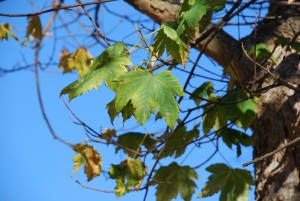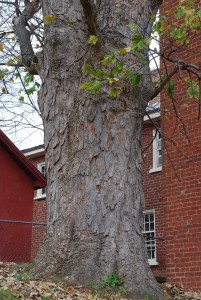Sycamore maple, aka planetree maple (Acer pseudoplatanus) is indigenous to northern and central Europe where it is a popular landscape tree. Very commonly planted in the northeastern U.S. in the early 20th century, this large 50-60 foot tree is rarely found today (USDA zones 4 and 7). A mature specimen in Jonesborough, Tennessee (zone 6) is over 80 feet in height.
The popularity of native red (A. rubrum) and sugar (A. saccharum) maples is the likely reason that it is no longer planted. Sycamore maple exhibits subpar summer heat tolerance which excludes its use in the southeastern U.S. The 4 – 6 inch broadly palmate leaves feel sand-papery to the touch. Leaf petioles are 4-5 inches long. Mature specimen trees display grayish brown bark which chips off in tiny narrow strips to expose orange-red inner wood. Its green clusters flowers in spring contribute little to the tree’s overall stature; leaves turn a bland yellowish brown before abscising.
There are two diminutive cultivars which are more deserving your planting attention. ‘Brilliantissima’ exhibits salmon pink spring foliage which turns bright lime-green in summer. ‘Esk Sunset’ foliage starts off with pink, green and white variegation, and turns lemony green in the summer. Both cultivars grow very slowly, perhaps to less than a third the size of species (20-40 feet in height and 12-15 feet in spread).
Sycamore maple grows in average well-drained soil and is not pH sensitive, even high lime soils. Leaves are exceptionally tolerant of salt and urban air pollutants. Annual growth rate is fast and the upright branches of this hardwood maple are very sturdy. Sycamore maple distribute thousands of fertile double winged samaras (“whirligigs”)annually and seeds invade surrounding landscapes. Pennsylvania lists sycamore maple as invasive.
Sycamore maple is available from a number of on-line nurseries.



 Posted in
Posted in 
